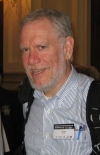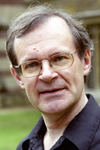Director's Corner
12 April 2007
 Barry Barish |
Organising the GDE for the ILC engineering design phase
The next big milestone for the GDE is to develop an engineering design and document it in an Engineering Design Report (EDR). The Reference Design we have developed over the past year is a complete description of the ILC, but without much of the detailed engineering needed to make a full-fledged funding proposal. We expect the next phase will take about three years and will include detailed and reliable costing, as well as critical R&D results and demonstrations that are needed to support the proposal. We have been discussing and planning for this next phase for some time. In order to develop a concrete plan, I recently appointed an EDR Planning Task Force, under the leadership of Marc Ross, to analyse specific organisational models and structures.
 Marc Ross (Fermilab), who is leading the task force on EDR Plannings Marc Ross (Fermilab), who is leading the task force on EDR Plannings |
 Brian Foster (Oxford), who led the EC study producing the general principles for organising the ILC Engineering Design Phase Brian Foster (Oxford), who led the EC study producing the general principles for organising the ILC Engineering Design Phase |
We began to prepare for the EDR phase late last summer. From the beginning, we recognised the importance of careful planning and placed this subject as a regular agenda item for our weekly GDE Executive Committee (EC) meetings. Our continuing dialogue was led by Brian Foster (Oxford), who also did considerable homework on how other large projects have approached this problem. We developed our ideas and shared and discussed them with other GDE members at our workshop in Valencia last November, and then in a more mature form in Beijing in February. A short white paper was presented to the International Linear Collider Steering Committee (ILCSC) following that meeting. A key conclusion was that the next phase should incorporate what will be needed to accomplish the engineering design by evolution, not revolution of the present GDE organisation. The paper recognised that substantial reform of its membership and structure will be required though.
Perhaps the most important conclusion from the EC discussions was to establish a more traditional project management structure within the GDE -- one that will give the project manager sufficient authority to manage the EDR phase. We are working toward creating a Project Management office, and I will report on that subject soon. The other key recommendation was that we employ a work package structure for organising and dividing up both the engineering design and R&D efforts, defining deliverables, reporting and accountability.
The EDR Planning Task Force has been created to help us develop a detailed plan for organising the Work Breakdown Structure (WBS) and, in fact, the detailed work packages we will need to do the work toward the EDR. The work of this task force should enable the new project management to become operational in a timely manner and with well thought out organisational structures. Marc Ross and colleagues are scheduling a weekly teleconference, planning face-to-face meetings with key groups and generally being broadly interactive within the GDE. The LCWS meeting in DESY will provide a milestone in this planning process where the task force will report its findings, as well as a forum to carry out broad discussions within the GDE community.
The EDR Planning Task Force consists of M. Ross (chair), H. Hayano, R. Kephart, L. Lilje, K. Oide, E. Paterson, N. Toge, A. Wolski. The members of the GDE Executive Committee will serve as ex-officio members. The group is getting off to a quick start and is already busily interpreting the charge, working to define the EDR and its timescales, and how should they organise their work. This summer, we will present the final ILC Reference Design to FALC and ILCSC/ICFA. At the same meetings, we will present our plan for the EDR and associated global R&D plan. By next autumn, we hope to be well underway on the next phase of our great adventure!
-- Barry Barish